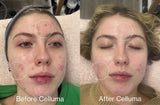

Treatment: 3x per week for 4 weeks. No other modalities used.
How it Works
The standard acne protocol is to use Celluma on the Acne setting 3x per week for 4 weeks for best results. Using Celluma LED light therapy devices is very relaxing. Settle into a comfortable position and wrap the treatment area with your Celluma. A single treatment lasts approximately 30 minutes. Most people experience immediate results. Results vary depending on the severity of the condition and adherence to protocols. Statistics from research referenced below.
54 %
saw improvement in acne lesions with blue light acne treatment. PubMed 2010
76 %
saw improvement in in acne lesions with red + blue light acne treatment
80 %
saw improvement in skin texture after light therapy treatment
When a particularly extreme acne breakout happens, it can feel like nothing works fast enough to get us back in the clear. LED Light Therapy for acne is a tremendous treatment option for faster results. See what the research says about light therapy for acne.
2 studies
Keys to Effective Low Level Light Therapy (LLLT). Stanford School of Medicine, 2016
The Nuts and Bolts of Low-level Laser (Light) Therapy. PubMed, 2012
2 studies
Effect of Blue Light on Acne Vulgaris: A Systematic Review. Sensors (Basel), 2021
Blue and red light combination LED phototherapy for acne vulgaris in patients with skin phototype IV. Lasers Surg. Med., 2007
2 studies
Low Level Light Therapy with Light-Emitting Diodes for the Aging Face. Clinics In Plastic Surgery, 2016
Low Level Laser (Light) Therapy (LLLT) for Cosmetic Medicine and Dermatology. Photobiology.info, 2014
WE'RE HERE TO HELP
Low-level-light therapy or photobiomodulation is based on Light Emitting Diode (LED) technology and is the application of light energy to the body for therapeutic benefits. It promotes a natural photobiochemical reaction similar to the process of plant photosynthesis. The energy delivered by the LEDs has been shown to enhance cellular metabolism, accelerate the repair and replenishment of damaged skin cells, as well as stimulate the production of collagen — the foundation of healthy, smooth skin. Research has shown that LED light therapy may help smooth skin texture, improve skin firmness and resilience, increase lymphatic system activity, restore skin’s natural cellular activity, and reduce the appearance of fine lines, wrinkles, and superficial hyperpigmentation. The treatment is for all skin types, and is non-ablative, non-invasive, painless, and requires absolutely no downtime. Patients or clients can return to their normal activity immediately after the treatment.
Blue light energy typically penetrates the skin at a shallow depth compared to other types of light energy such as infrared or red light. Blue light, in the range of 400 to 495 nanometers, generally penetrates the skin to the depth of the epidermis, the outer most layer of the skin. Its ability to reach deeper layers is limited, which is why it is often used for targeting skin concerns closer to the surface, such as acne. Blue light therapy is known for its effectiveness in treating acne by targeting the bacteria that contribute to breakouts within the skin’s superficial layers. Based on clinical research, Celluma devices use blue light at 465 nanometers.
Over time, as bacteria are reduced and pores clear, many users notice smoother, clearer skin. Blue light therapy can result in a more even skin tone after repeated treatments.
LED devices are considered extremely low risk when used as intended.
Position Celluma as close to your skin as possible, the closer the better. One key advantage to Celluma is its patented flexible design, which allows for close positioning to the skin, and may lead to more effective results.
Typically, users see noticeable results after about four to six treatments. However, the exact number can vary depending on the individual’s skin condition and the severity of the acne. For mild to moderate acne, blue light therapy often requires consistent sessions over several weeks for optimal results.
For maximum benefits, use Celluma for 30 minutes on the ACNE mode which emits blue light to kill acne bacteria and red light to reduce inflammation, increase circulation, and promote tissue repair.
You can use blue light therapy daily, but it depends on the device and your skin’s tolerance. For some, daily use may be too frequent, causing irritation. It’s essential to follow the recommended guidelines for your specific device or consult with a dermatologist to determine the ideal frequency for treating acne without overloading the skin.
Absolutely! The closer to the skin the better. The only time you won’t want Celluma to touch the skin is when you are treating open wounds and concerned about cross-contamination. In these cases, we recommend using the Celluma disposable hygiene barriers.

